Nanjing’s Intracity Tourism Flow Network Using Cellular Signaling Data: A Comparative Analysis of Residents and Non-Local Tourists
Abstract
:1. Introduction
2. Materials and Methods
2.1. Research Districts
2.2. Data Sources
2.3. Research Methods
2.3.1. Methods for Analyzing Tourism Flow Network Connections
2.3.2. Methods for Analyzing Node Centrality in Tourism Flow Networks
- In-degree centrality (popularity and attractiveness)
- Eigenvector centrality (latent attractiveness)
- Betweenness centrality (controlling ability of mediation)
2.3.3. Methods for Analyzing the Communities in the Tourism Flow Network
3. Results
3.1. Analysis of Tourism Network Connections
3.1.1. Spatial Concentration of the Tourism Flow Network
3.1.2. Analysis of the Connection Strength of the Tourism Flow Network
3.2. Analysis of Node Centrality in the Tourism Flow Network
3.2.1. Node Centrality Analysis
- Popularity and Attraction of Network Nodes (In-degree Centrality)
- Latent Attraction of Network Nodes (Eigenvector Centrality)
- Mediating and Controlling Power of Network Nodes (Betweenness centrality)
3.2.2. Evaluation of Node Status Based on Node Centrality
3.3. Analysis of Tourism Flow Network Communities
3.3.1. Cohesive Subgroup Analysis of the Tourism Flow Network
3.3.2. “Core-Edge” Model
4. Discussion
Author Contributions
Funding
Data Availability Statement
Conflicts of Interest
References
- Castells, M. Rise of the Network Society; Blackwell Publishers: Oxford, UK, 1996. [Google Scholar]
- Feng, Z. Tourism and transport: Modes, networks and flows. Tour. Geogr. 2010, 12, 579–582. [Google Scholar] [CrossRef]
- Zhang, J.; Jensen, C. Comparative advantage—Explaining tourism flows. Ann. Tour. Res. 2007, 34, 223–243. [Google Scholar] [CrossRef]
- Hills, L.; Lundgren, J. The impact of tourism in the Caribbean: A methodological study. Ann. Tour. Res. 1977, 5, 248–267. [Google Scholar] [CrossRef]
- Lundgren, J. Geographic concepts and the development of tourism research in Canada. Geo J. 1984, 9, 17–25. [Google Scholar] [CrossRef]
- Prideaux, B. Factors affecting bilateral tourism flows. Ann. Tour. Res. 2005, 32, 780–801. [Google Scholar] [CrossRef]
- Jensen, C.; Zhang, J. Trade in tourism services: Explaining tourism trade and the impact of the general agreement on trade in services on the gains from trade. J. Int. Trade Econ. Dev. 2013, 22, 398–429. [Google Scholar] [CrossRef]
- Santeramo, F.G.; Morelli, M. Modelling tourism flows through gravity models: A quantile regression approach. Curr. Issues Tour. 2015, 19, 1077–1083. [Google Scholar] [CrossRef]
- Sharipov, S.; Demirkol, H.G. Analysing the flow pattern in the tourism city of eskisehir. Int. J. Tour. Cities 2018, 4, 342–354. [Google Scholar] [CrossRef]
- Ding, Z. A Research on the Space-Time Evolution of the Domestic Tourist Flow in Nanjing. Tour. Trib. 2004, 2, 37–40. [Google Scholar]
- Zhang, Y.; Ma, Y.; Ma, H.; Gu, J. Research on the Transition of the Equilibrium Point of Inbound Agglomeration and Diffusion Tourism Flow in Beijing. Tour. Trib. 2009, 24, 31–35. [Google Scholar]
- Hong, T.; Ma, T.; Huan, T.-C. Network behavior as driving forces for tourism flows. J. Bus. Res. 2015, 68, 146–156. [Google Scholar] [CrossRef]
- Qiu, Y.; Ge, P.; Ren, P. An Empirical Study on Cluster Distributaries of the Initial State of Jiuzhaigou. Resour. Sci. 2010, 32, 118–123. [Google Scholar]
- Jin, Z. An Analysis of Optimization Effects of the Changes in Product Spatial Structure of Tourist Flow—A Case Study on Hangzhou. Tour. Trib. 2006, 7, 42–47. [Google Scholar]
- Jin, C.; Cheng, J.; Xu, J. Using User-Generated Content to Explore the Temporal Heterogeneity in Tourist Mobility. J. Travel Res. 2018, 57, 779–791. [Google Scholar] [CrossRef]
- Liu, Z.; Li, H.; Shi, C.; Wang, X.; Zhang, H. Response of Temporal Distribution of Short-term Tourist Flows to Regional Tourism Spatial Structure—A Case Study of Golden Week Tourist Flows in Yunnan Province. Acta Geogr. Sin. 2010, 65, 1624–1632. [Google Scholar] [CrossRef]
- Liu, F.; Zhang, J.; Zhang, J.; Chen, D.; Liu, Z.; Lu, S. Roles and functions of tourism destinations in tourism region of south anhui: A tourist flow network perspective. Chin. Geogr. Sci. 2012, 22, 755–764. [Google Scholar] [CrossRef]
- Wang, Z.; Liu, Q.; Xu, J.; Fujiki, Y. Evolution characteristics of the spatial network structure of tourism efficiency in china: A province-level analysis. J. Destin. Mark. Manag. 2020, 18, 100509. [Google Scholar] [CrossRef]
- Li, A.; Mou, N.; Zhang, L.; Yang, T.; Liu, W.; Liu, F. Tourism Flow Between Major Cities during China’s National Day Holiday: A Social Network Analysis Using Weibo Check-in Data. IEEE Access 2020, 8, 225675–225691. [Google Scholar] [CrossRef]
- Sun, Y.; Shao, Y.; Chan, E. Co-visitation network in tourism-driven peri-urban area based on social media analytics: A case study in Shenzhen, China. Landsc. Urban Plan. 2020, 204, 103934. [Google Scholar] [CrossRef]
- Chen, Y.; Chen, R.; Hou, J.; Hou, M.; Xie, X. Research on users’ participation mechanisms in virtual tourism communities by bayesian network. Knowl.-Based Syst. 2021, 226, 107161. [Google Scholar] [CrossRef]
- Heinz, E. Social Structures: A Network Approach; Cambridge University Press: New York, NY, USA, 1989. [Google Scholar]
- Hu, M.; Qiu, R.T.R.; Wu, D.C.; Song, H. Hierarchical pattern recognition for tourism demand forecasting. Tour. Manag. 2021, 84, 104263. [Google Scholar] [CrossRef]
- Chen, S.; Wang, X.; Zhang, H.; Wang, J.; Peng, J. Customer purchase forecasting for online tourism: A data-driven method with multiplex behavior data. Tour. Manag. 2021, 87, 104357. [Google Scholar] [CrossRef]
- Nistor, M.M.; Nicula, A.-S.; Dezsi, S.; Petrea, D.; Kamarajugedda, S.A.; Carebia, I.A. Gis-based kernel analysis for tourism flow mapping. J. Settl. Spat. Plan. 2020, 11, 137–145. [Google Scholar] [CrossRef]
- Li, T.; Li, Q.; Liu, J. The spatial mobility of rural tourism workforce: A case study from the micro analytical perspective. Habitat Int. 2021, 110, 102322. [Google Scholar] [CrossRef]
- Oender, I.; Koerbitz, W.; Hubmann-Haidvogel, A. Tracing tourists by their digital footprints: The case of Austria. J. Travel Res. 2016, 55, 566–573. [Google Scholar] [CrossRef]
- Comito, C. NexT: A framework for next-place prediction on location based social networks. Knowl.-Based Syst. 2020, 204, 106205. [Google Scholar] [CrossRef]
- Shakeri, E.; Far, B.H. Exploring the requirements of pandemic awareness systems: A case study of COVID-19 using social media data. In Proceedings of the 35th IEEE/ACM International Conference on Automated Software Engineering Workshops, Association for Computing Machinery, Virtual Event, Australia, 21–25 December 2020; pp. 33–40. [Google Scholar]
- Nurbakova, D.; Ermakova, L.; Ovchinnikova, I. In Understanding the Personality of Contributors to Information Cascades in Social Media in Response to the COVID-19 Pandemic. In Proceedings of the 2020 International Conference on Data Mining Workshops (ICDMW), Sorrento, Italy, 17–20 November 2020; pp. 45–52. [Google Scholar]
- Qian, C.; Li, W.; Duan, Z.; Yang, D.; Ran, B. Using mobile phone data to determine spatial correlations between tourism facilities. J. Transp. Geogr. 2021, 92, 103018. [Google Scholar] [CrossRef]
- Hanneman, R.; Riddle, M. Introduction to Social Network Methods; University of California: Los Angeles, CA, USA, 2005. [Google Scholar]
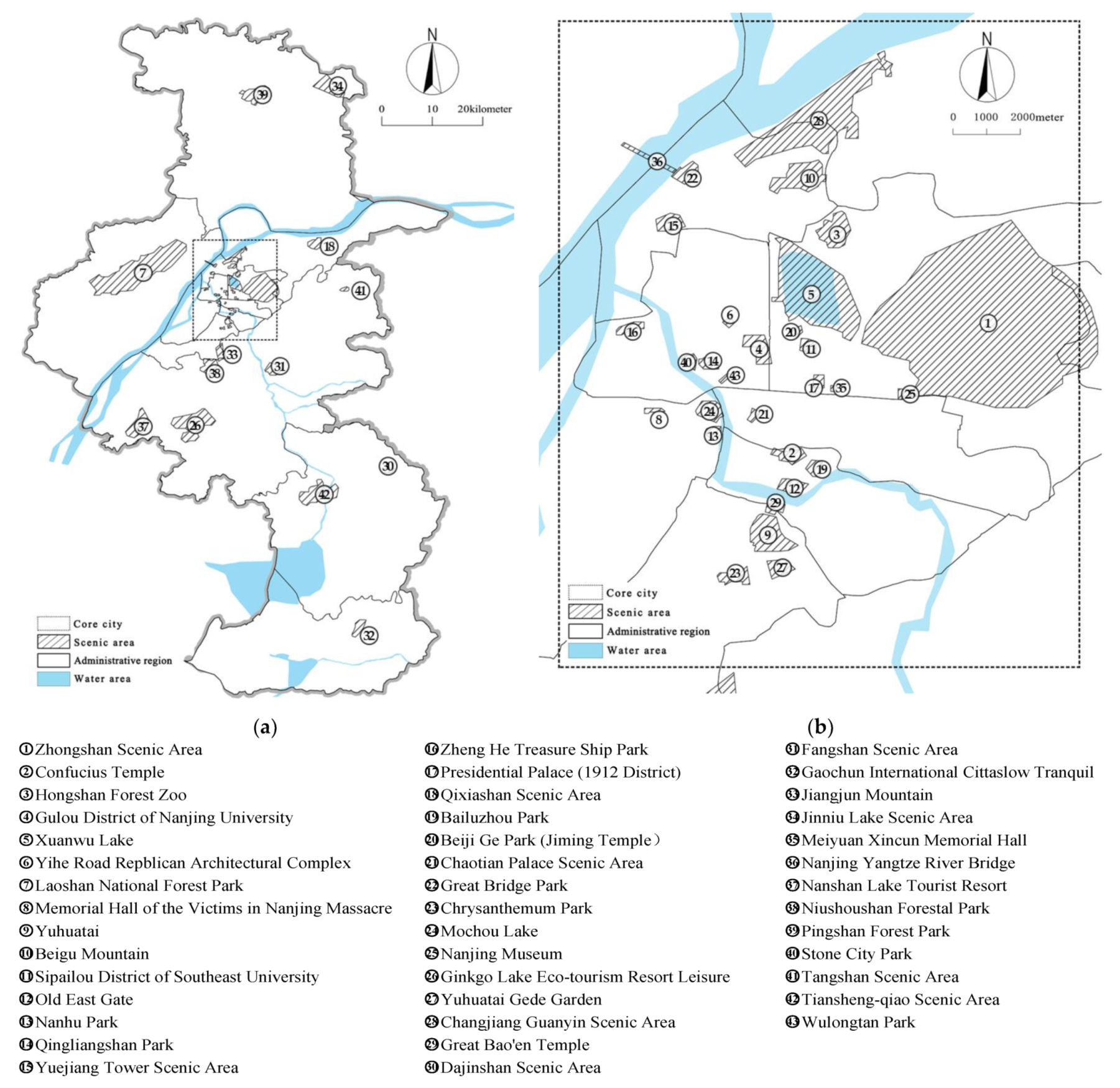
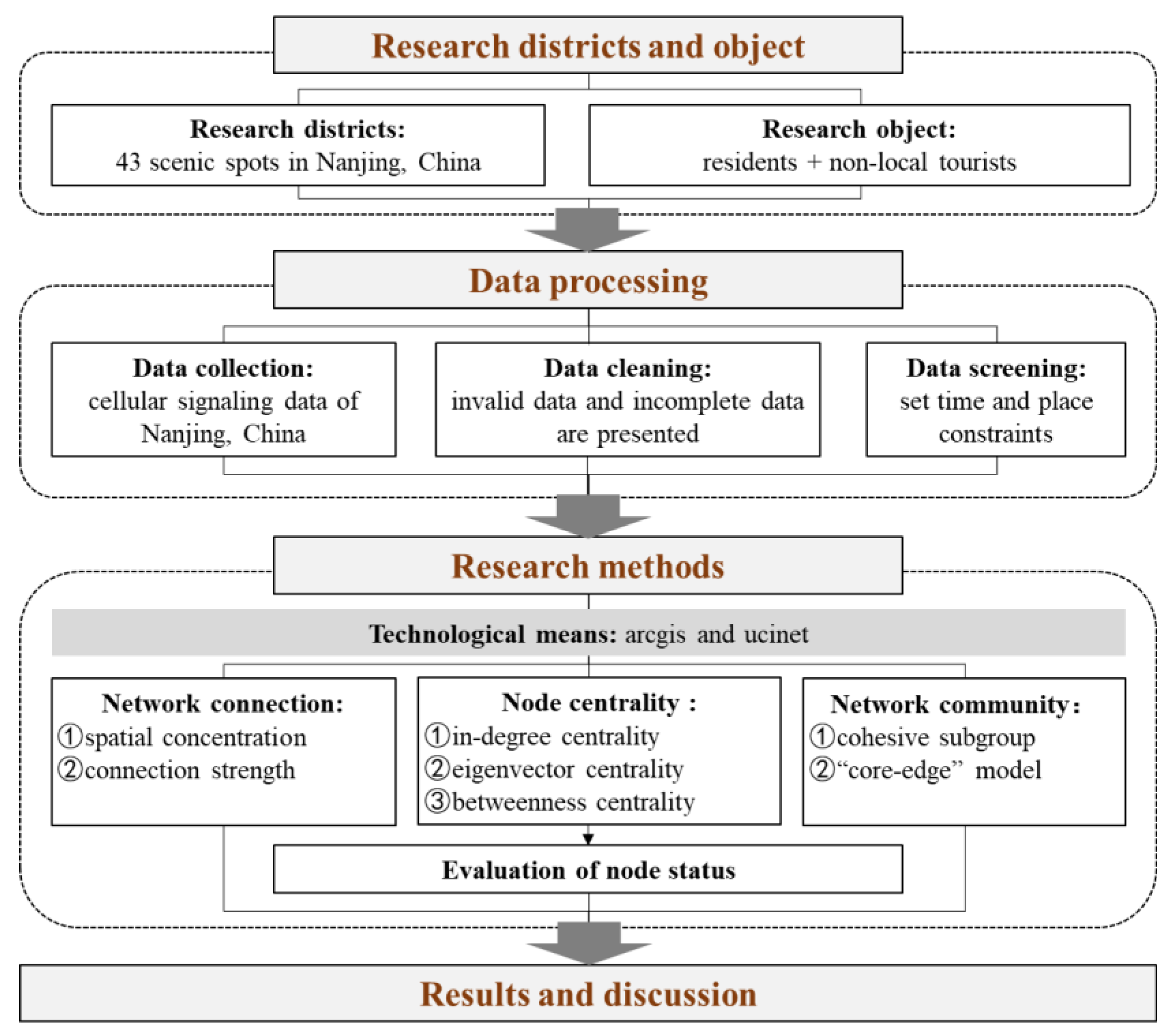

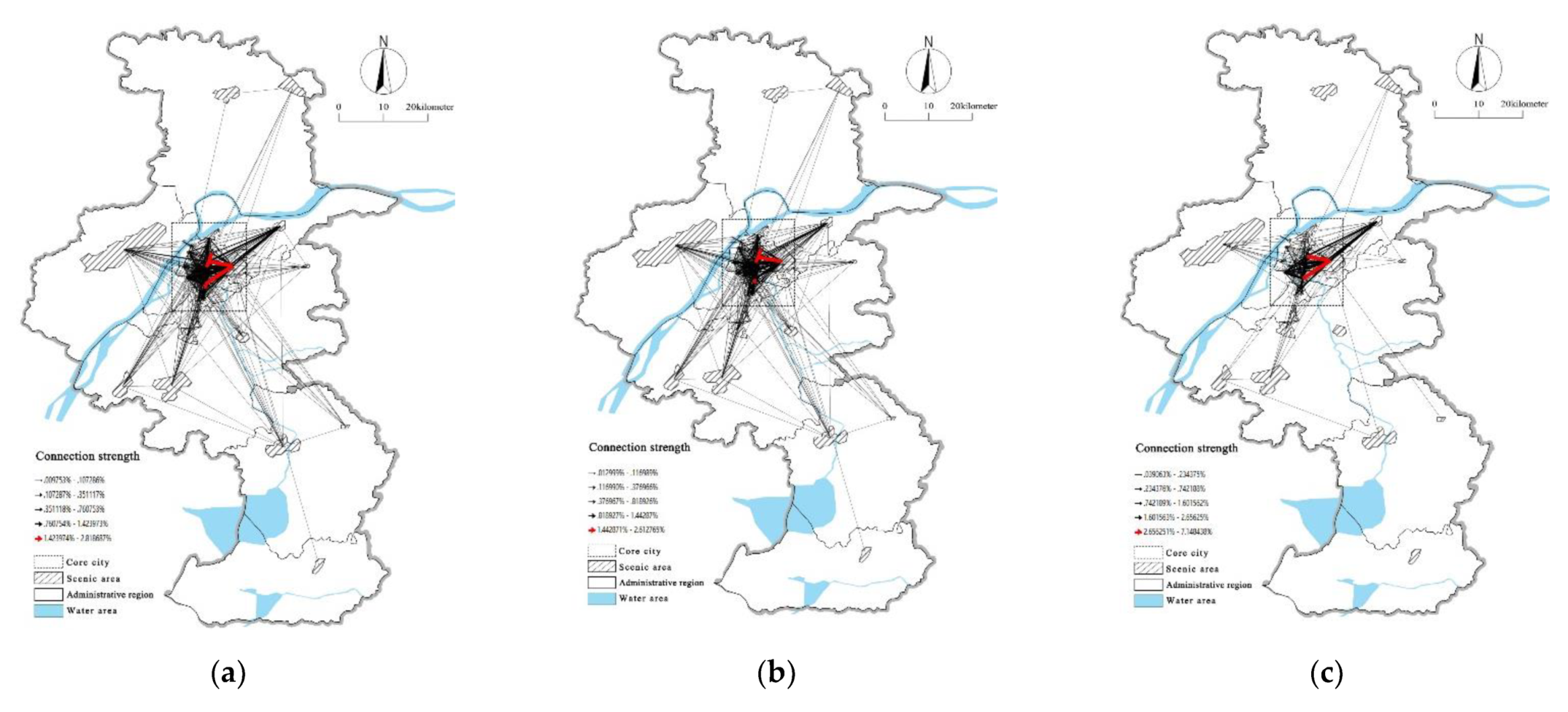


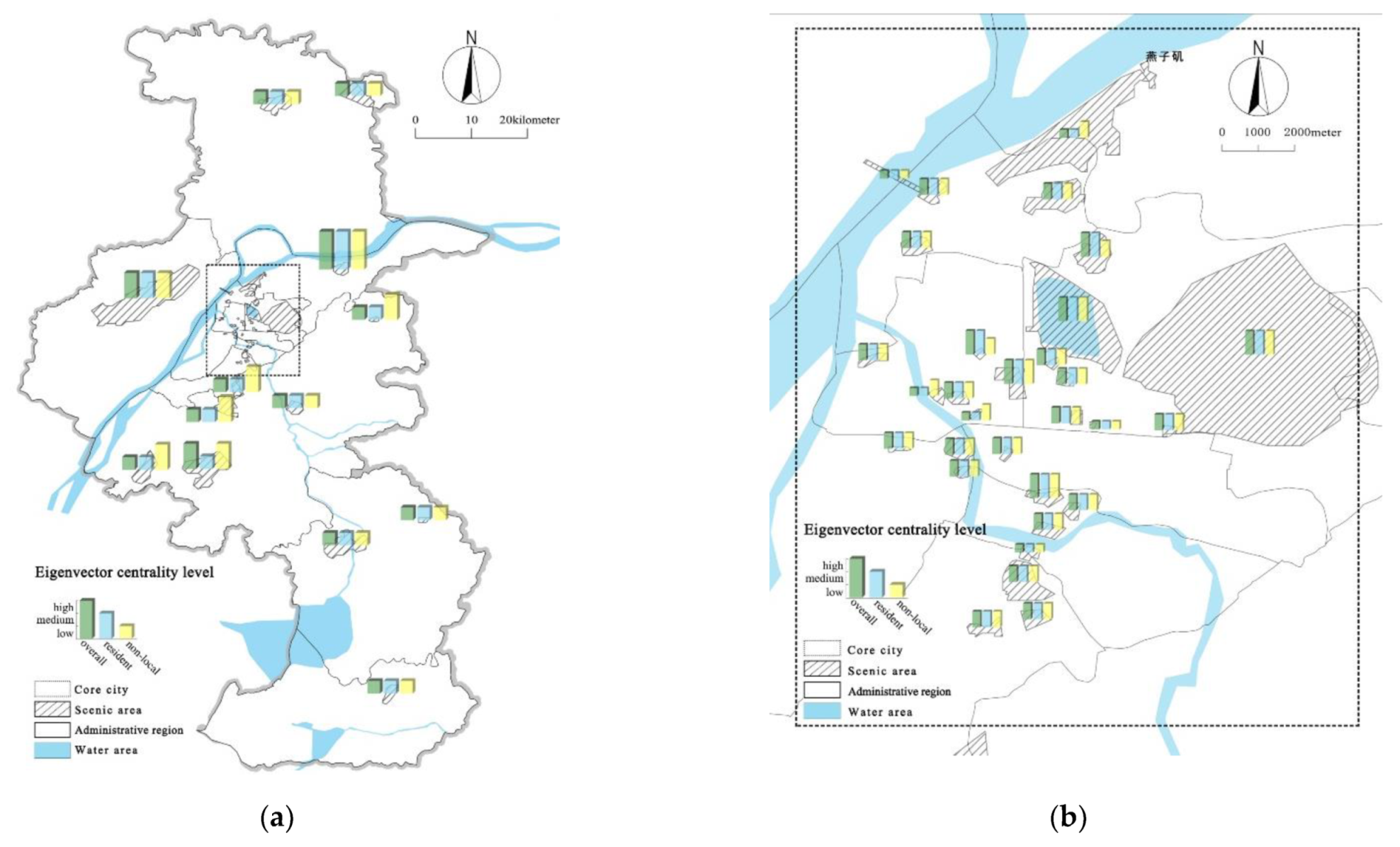

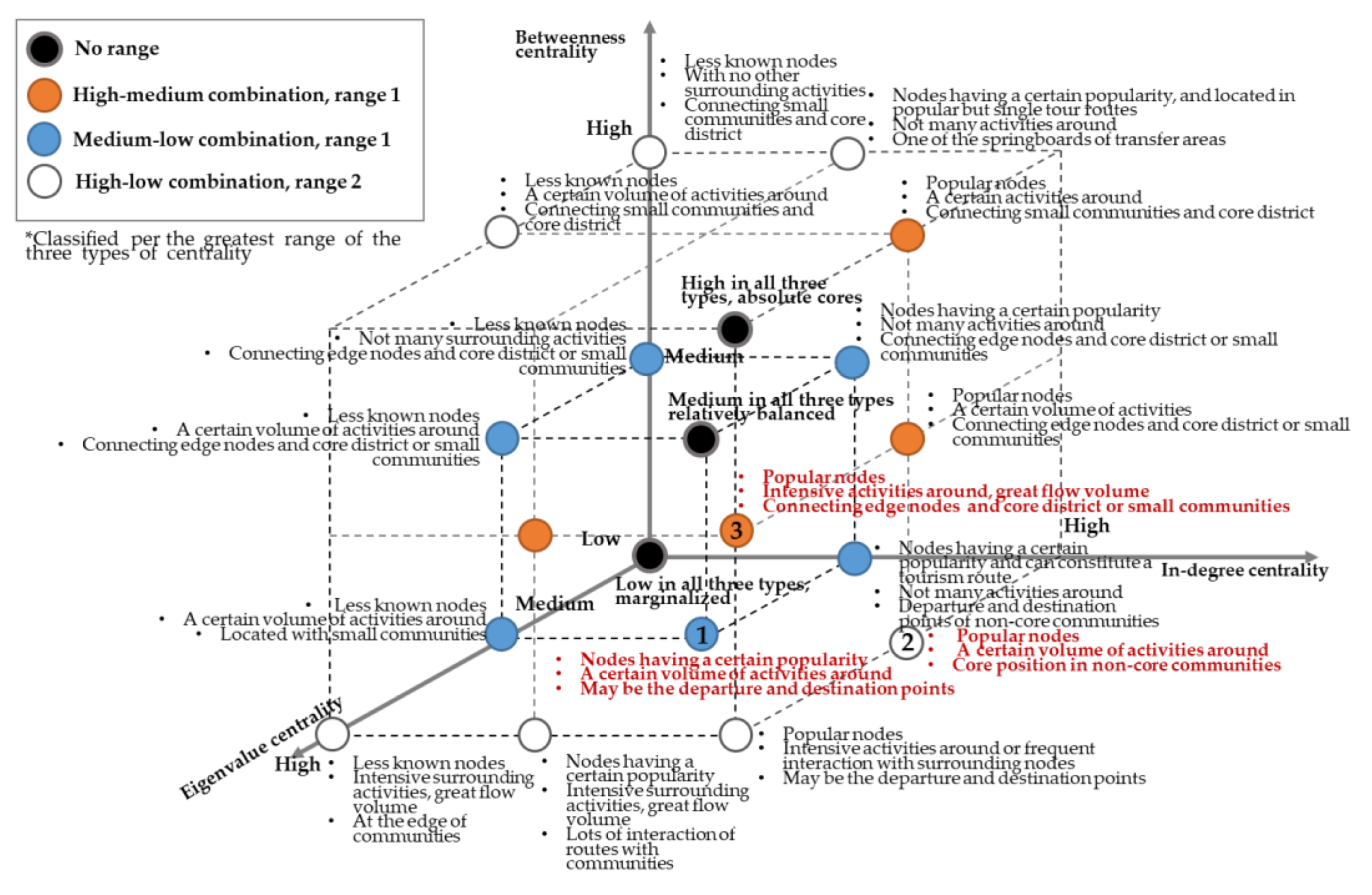
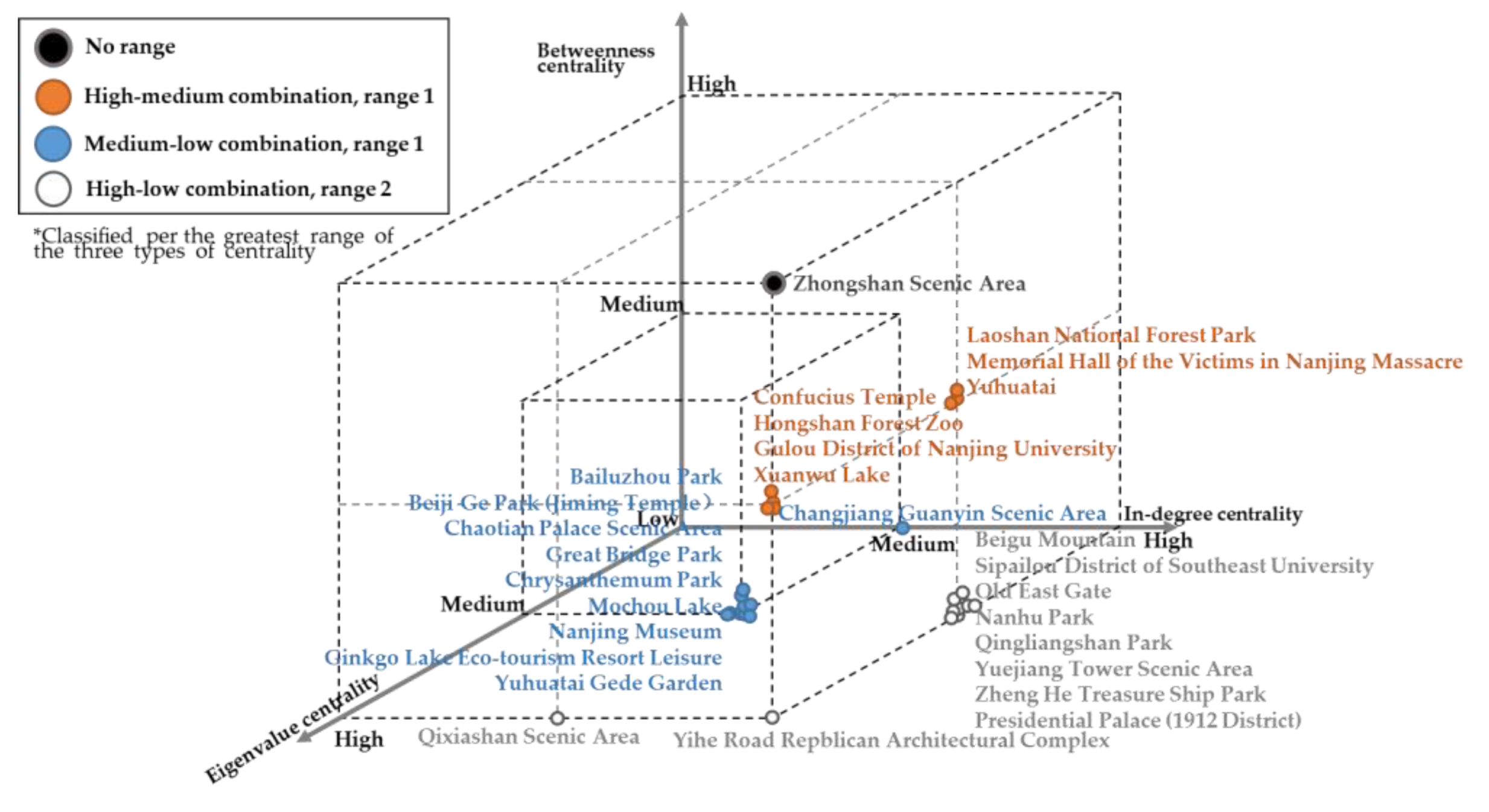
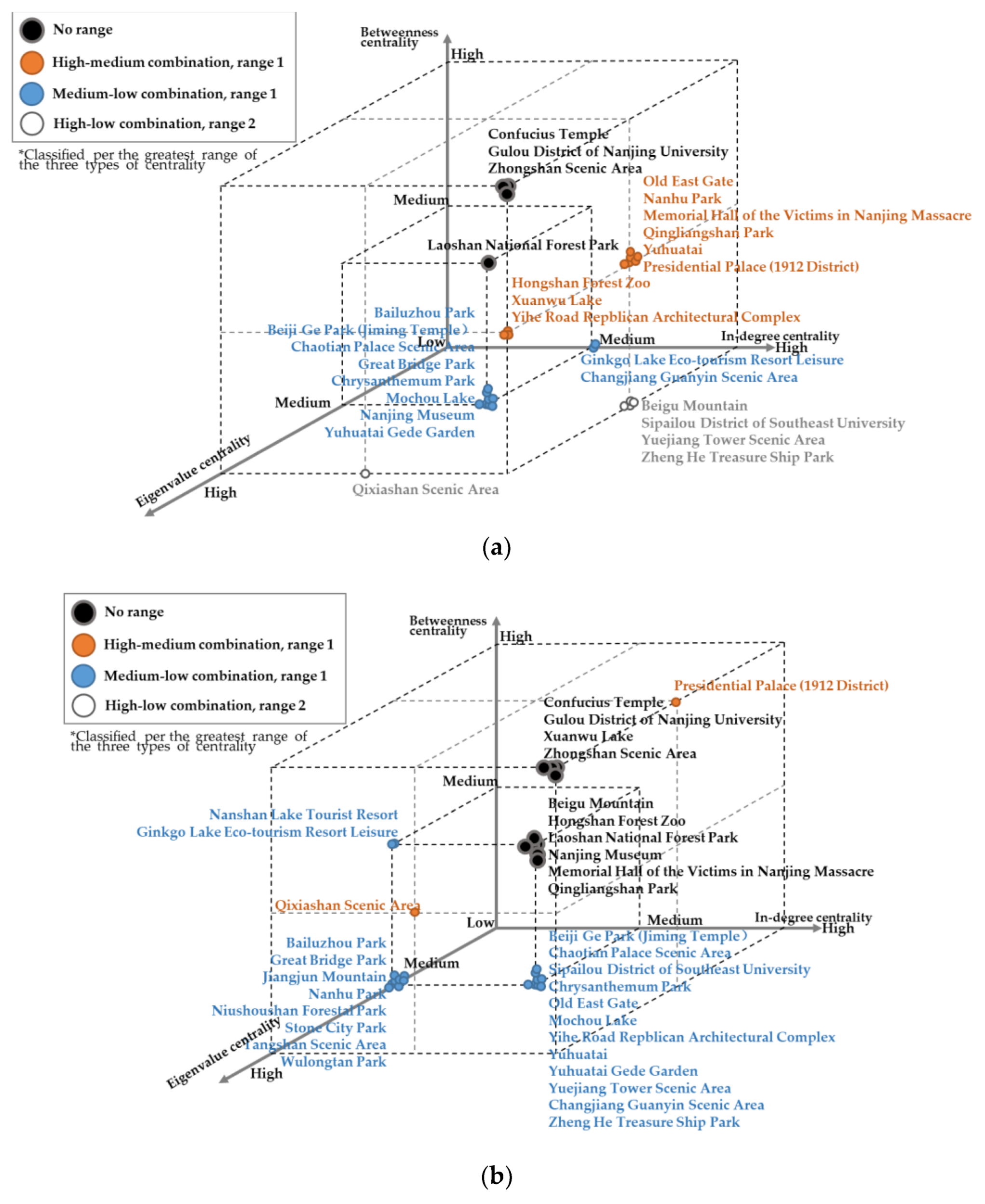
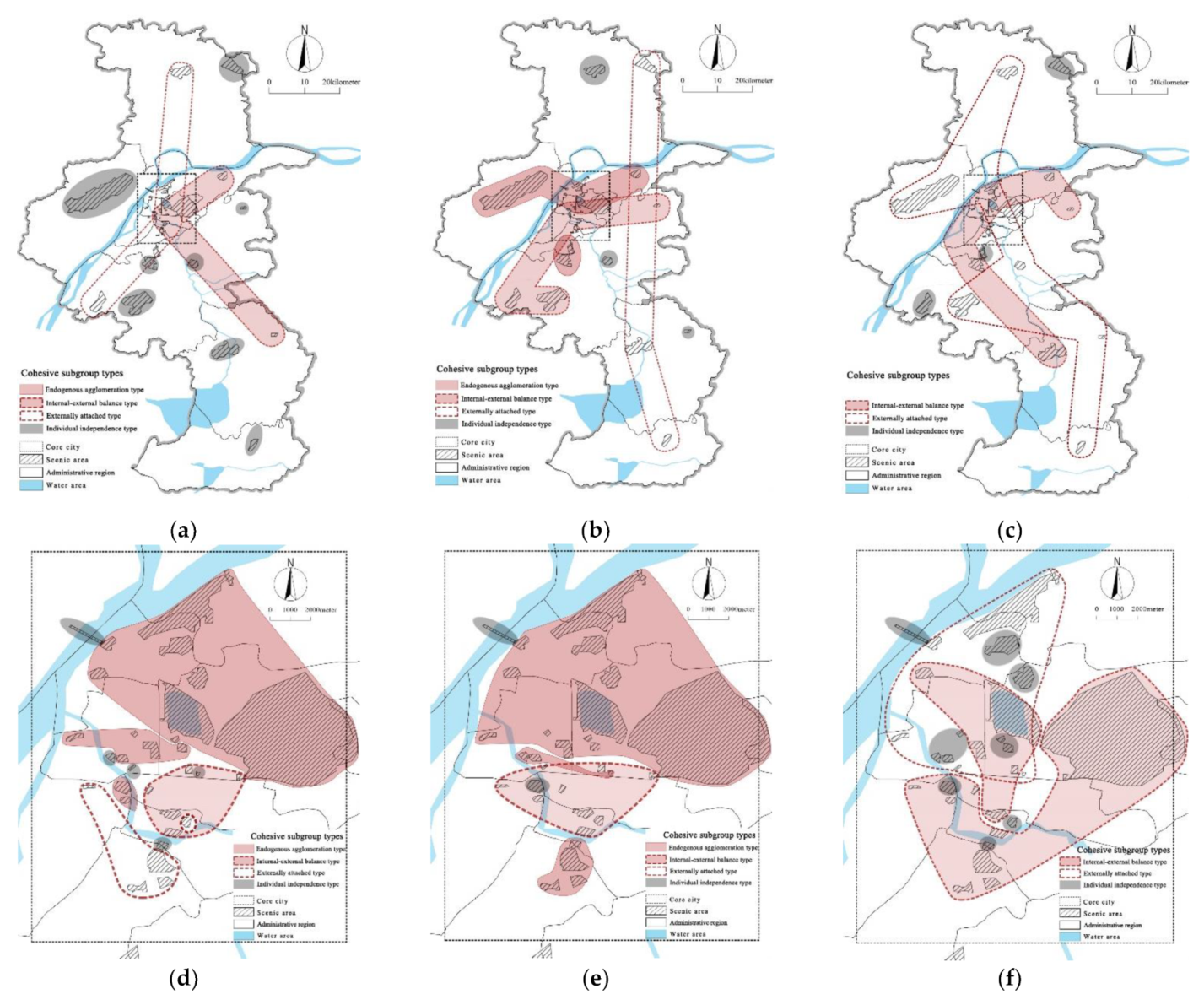
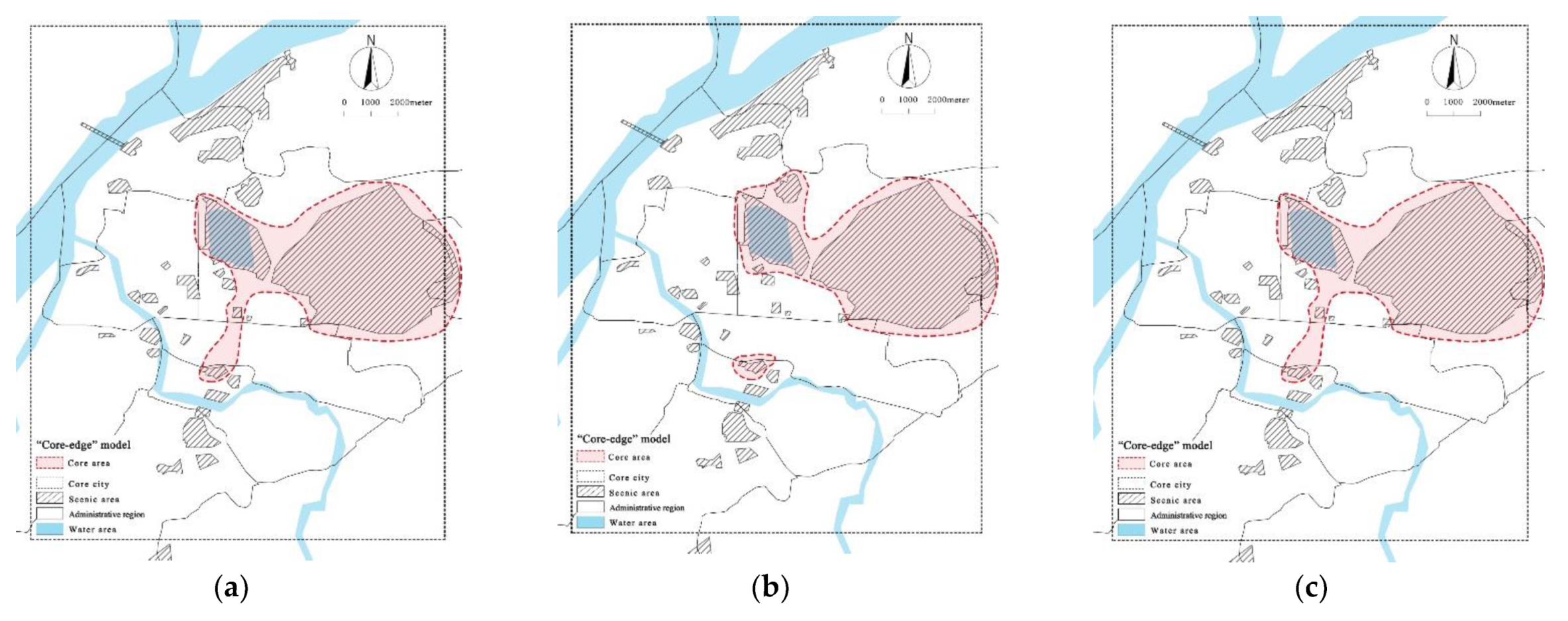
| Low In-Degree Centrality | Low Eigenvector Centrality | Low Betweenness Centrality | |
|---|---|---|---|
| High in-degree centrality | — | Nodes in more popular areas, although in single tourism routes. | Nodes themselves are popular, although they are usually treated as the departure and destination points on tourism routes. |
| High eigenvector centrality | Exist in the areas around nodes of high popularity. | — | Nodes and their adjacent nodes are located in areas of highly intensive activity, and possess interactive diversity. |
| High betweenness centrality | Although less known, such nodes are located where visitors are highly likely to pass on their way to access other nodes. | Rare type. Nodes in a monopoly position when connecting with marginal nodes, and are areas of highly intensive activity. | — |
| In-Degree Centrality | Eigenvector Centrality | Betweenness Centrality | |||||||
|---|---|---|---|---|---|---|---|---|---|
| Overall | Resident | Non-Local Tourist | Overall | Resident | Non-Local Tourist | Overall | Resident | Non-Local Tourist | |
| Zhongshan Scenic Area | 0.929 | 0.929 | 0.667 | 0.977 | 0.913 | 1 | 0.109 | 0.101 | 0.148 |
| Confucius Temple | 0.833 | 0.833 | 0.667 | 0.933 | 0.894 | 0.913 | 0.049 | 0.051 | 0.138 |
| Gulou District of Nanjing University | 0.833 | 0.81 | 0.595 | 0.933 | 0.933 | 0.875 | 0.043 | 0.052 | 0.091 |
| Xuanwu Lake | 0.786 | 0.714 | 0.667 | 0.857 | 0.857 | 0.824 | 0.029 | 0.025 | 0.084 |
| Yihe Road Repblican Architectural Complex | 0.738 | 0.714 | 0.214 | 0.84 | 0.84 | 0.618 | 0.018 | 0.023 | 0.001 |
| Hongshan Forest Zoo | 0.738 | 0.738 | 0.381 | 0.824 | 0.824 | 0.712 | 0.027 | 0.034 | 0.014 |
| Qingliangshan Park | 0.738 | 0.714 | 0.31 | 0.808 | 0.764 | 0.667 | 0.018 | 0.018 | 0.015 |
| Memorial Hall of the Victims in Nanjing Massacre | 0.69 | 0.667 | 0.357 | 0.792 | 0.737 | 0.724 | 0.031 | 0.031 | 0.014 |
| Yuhuatai | 0.69 | 0.69 | 0.31 | 0.792 | 0.778 | 0.7 | 0.026 | 0.028 | 0.007 |
| Old East Gate | 0.69 | 0.667 | 0.214 | 0.764 | 0.75 | 0.689 | 0.015 | 0.015 | 0.004 |
| Presidential Palace (1912 District) | 0.667 | 0.667 | 0.762 | 0.792 | 0.792 | 0.689 | 0.012 | 0.014 | 0.153 |
| Beigu Mountain | 0.667 | 0.667 | 0.31 | 0.792 | 0.778 | 0.677 | 0.01 | 0.012 | 0.013 |
| Sipailou District of Southeast University | 0.667 | 0.667 | 0.286 | 0.712 | 0.712 | 0.646 | 0.007 | 0.008 | 0.003 |
| Nanhu Park | 0.643 | 0.643 | 0.143 | 0.778 | 0.764 | 0.636 | 0.016 | 0.016 | 0.004 |
| Zheng He Treasure Ship Park | 0.619 | 0.595 | 0.262 | 0.792 | 0.792 | 0.667 | 0.007 | 0.009 | 0.002 |
| Laoshan National Forest Park | 0.619 | 0.548 | 0.238 | 0.778 | 0.778 | 0.646 | 0.056 | 0.035 | 0.023 |
| Yuejiang Tower Scenic Area | 0.619 | 0.595 | 0.286 | 0.737 | 0.724 | 0.636 | 0.01 | 0.012 | 0.002 |
| Qixiashan Scenic Area | 0.571 | 0.524 | 0.31 | 0.857 | 0.824 | 0.808 | 0.014 | 0.013 | 0.028 |
| Chaotian Palace Scenic Area | 0.571 | 0.524 | 0.286 | 0.7 | 0.7 | 0.609 | 0.004 | 0.004 | 0 |
| Yuhuatai Gede Garden | 0.548 | 0.524 | 0.262 | 0.792 | 0.764 | 0.677 | 0.008 | 0.008 | 0.007 |
| Overall | 1 | 2 | 3 | 4 | 5 | 6 | 7 | 8 |
|---|---|---|---|---|---|---|---|---|
| 1 | 0.000 | 0.241 | 1.000 | 1.000 | 0.065 | 0.039 | 0.463 | 0.000 |
| 2 | 0.004 | 0.000 | 0.000 | 0.049 | 0.029 | 0.183 | 0.048 | 0.002 |
| 3 | 1.000 | 0.328 | 0.460 | 0.000 | 0.162 | 0.124 | 0.362 | 0.043 |
| 4 | 0.277 | 0.188 | 0.017 | 0.074 | 0.000 | 0.000 | 0.000 | 0.000 |
| 5 | 0.228 | 0.553 | 0.324 | 0.162 | 1.000 | 0.541 | 0.885 | 0.048 |
| 6 | 0.096 | 1.000 | 0.198 | 0.000 | 0.479 | 1.000 | 0.374 | 0.049 |
| 7 | 0.448 | 0.706 | 0.441 | 0.239 | 0.461 | 0.340 | 1.000 | 0.047 |
| 8 | 0.067 | 0.281 | 0.349 | 0.000 | 0.101 | 0.177 | 0.329 | 1.000 |
| AVG1 (degree of internal connection) | 0.000 | 0.000 | 0.230 | 0.037 | 0.500 | 0.500 | 0.500 | 0.500 |
| AVG2 (degree of external connection) | 0.352 | 0.258 | 0.311 | 0.138 | 0.288 | 0.257 | 0.367 | 0.107 |
| Type | Overall (R2 = 0.159) |
| Endogenous agglomeration type | 1. Changjiang Guanyin Scenic Area, Hongshan Forest Zoo, Great Bridge Park, Beigu Mountain, Beiji Ge Park (Jiming Temple), Yuejiang Tower Scenic Area, Xuanwu Lake, Zhongshan Scenic Area |
| 2. Sipailou District of Southeast University, Yihe Road Repblican Architectural Complex, Zheng He Treasure Ship Park, Gulou District of Nanjing University, Qingliangshan Park | |
| 3. Mochou Lake, Nanhu Park | |
| Internal-external balance type | 1. Dajinshan Scenic Area, Confucius Temple, Chaotian Palace Scenic Area, Qixiashan Scenic Area, Old East Gate, Nanjing Museum, Presidential Palace (1912 District) |
| Externally attached type | 1. Bailuzhou Park, Nanshan Lake Tourist Resort, Jiangjun Mountain, Pingshan Forest Park |
| 2. Yuhuatai, Yuhuatai Gede Garden, Memorial Hall of the Victims in Nanjing Massacre, Chrysanthemum Park | |
| Individual independence type | 1. Wulongtan Park, Great Bao’en Temple, Meiyuan Xincun Memorial Hall, Laoshan National Forest Park, Tangshan Scenic Area, Fangshan Scenic Area, Jinniu Lake Scenic Area, Stone City Park, Gaochun International Cittaslow Tranquil |
| 2. Tiansheng-qiao Scenic Area, Niushoushan Forestal Park, Nanjing Yangtze River Bridge, Ginkgo Lake Eco-tourism Resort Leisure | |
| Type | Resident (R2 = 0.155) |
| Endogenous agglomeration type | 1. Stone City Park, Qingliangshan Park, Meiyuan Xincun Memorial Hall |
| 2. Great Bridge Park, Laoshan National Forest Park, Yihe Road Repblican Architectural Complex, Changjiang Guanyin Scenic Area, Beiji Ge Park (Jiming Temple), Zheng He Treasure Ship Park, Beigu Mountain, Xuanwu Lake, Sipailou District of Southeast University, Zhongshan Scenic Area, Qixiashan Scenic Area, Yuejiang Tower Scenic Area, Hongshan Forest Zoo, Gulou District of Nanjing University | |
| 3. Chrysanthemum Park, Great Bao’en Temple, Yuhuatai, Yuhuatai Gede Garden | |
| 4. Jiangjun Mountain, Niushoushan Forestal Park | |
| Internal-external balance type | 1. Bailuzhou Park, Wulongtan Park, Presidential Palace (1912 District), Chaotian Palace Scenic Area, Ginkgo Lake Eco-tourism Resort Leisure, Old East Gate, Memorial Hall of the Victims in Nanjing Massacre, Confucius Temple, Nanjing Museum, Tangshan Scenic Area, Nanshan Lake Tourist Resort, Nanhu Park |
| Externally attached type | 1. Gaochun International Cittaslow Tranquil, Jinniu Lake Scenic Area, Tiansheng-qiao Scenic Area |
| Individual independence type | 1. Mochou Lake, Fangshan Scenic Area |
| 2. Nanjing Yangtze River Bridge, Dajinshan Scenic Area, Pingshan Forest Park | |
| Type | Non-local tourist (R2 = 0.089) |
| Internal-external balance type | 1. Xuanwu Lake, Tangshan Scenic Area, Niushoushan Forestal Park, Qixiashan Scenic Area, Presidential Palace (1912 District), Confucius Temple, Gulou District of Nanjing University, Tiansheng-qiao Scenic Area, Yuejiang Tower Scenic Area |
| 2. Old East Gate, Nanjing Museum, Chrysanthemum Park, Chaotian Palace Scenic Area, Nanhu Park, Yuhuatai, Yuhuatai Gede Garden, Memorial Hall of the Victims in Nanjing Massacre, Zhongshan Scenic Area | |
| Externally attached type | 1. Wulongtan Park, Ginkgo Lake Eco-tourism Resort Leisure, Dajinshan Scenic Area, Great Bridge Park, Meiyuan Xincun Memorial Hall, Fangshan Scenic Area, Zheng He Treasure Ship Park, Gaochun International Cittaslow Tranquil, Laoshan National Forest Park, Pingshan Forest Park, Changjiang Guanyin Scenic Area |
| Individual independence type | 1. Nanjing Yangtze River Bridge |
| 2. Jinniu Lake Scenic Area, Bailuzhou Park | |
| 3. Hongshan Forest Zoo, Sipailou District of Southeast University, Yihe Road Repblican Architectural Complex, Stone City Park, Nanshan Lake Tourist Resort, Beigu Mountain, Qingliangshan Park, Beiji Ge Park (Jiming Temple) | |
| 4. Jiangjun Mountain, Mochou Lake, Great Bao’en Temple |
| Overall | Resident | Non-Local Tourist | |
|---|---|---|---|
| Core | Confucius Temple, Presidential Palace (1912 District), Xuanwu Lake, Zhongshan Scenic Area (a total of 4, correlation = 0.782) | Zhongshan Scenic Area, Xuanwu Lake, Beiji Ge Park (Jiming Temple), Confucius Temple, Hongshan Forest Zoo (a total of 5, correlation = 0.710) | Zhongshan Scenic Area, Confucius Temple, Xuanwu Lake, Presidential Palace (1912 District) (a total of 4, correlation = 0.842) |
| Edge | Hongshan Forest Zoo, Gulou District of Nanjing University, Beiji Ge Park (Jiming Temple), Yuhuatai, Yihe Road Repblican Architectural Complex, Memorial Hall of the Victims in Nanjing Massacre, Qixiashan Scenic Area, Nanhu Park, Old East Gate, Qingliangshan Park, Nanjing Museum, Beigu Mountain, Sipailou District of Southeast University, Yuhuatai Gede Garden, Mochou Lake… (a total of 39, only the first 15 are listed, correlation = 0.081) | Yihe Road Repblican Architectural Complex, Gulou District of Nanjing Universit, Presidential Palace (1912 District), Nanhu Park, Qingliangshan Park, Old East Gate, Yuhuatai, Beigu Mountain, Sipailou District of Southeast University, Yuhuatai Gede Garden, Mochou Lake, Zheng He Treasure Ship Park, Yuejiang Tower Scenic Area, Memorial Hall of the Victims in Nanjing Massacre, Qixiashan Scenic Area… (a total of 38, only the first 15 are listed, correlation = 0.090) | Memorial Hall of the Victims in Nanjing Massacre, Gulou District of Nanjing University, Qixiashan Scenic Area, Nanjing Museum, Yuhuatai, Zheng He Treasure Ship Park, Hongshan Forest Zoo, Old East Gate, Laoshan National Forest Park, Nanhu Park, Sipailou District of Southeast University, Beigu Mountain, Beiji Ge Park (Jiming Temple), Yuhuatai, Qingliangshan Park… (a total of 39, only the first 15 are listed, correlation = 0.078) |
| Analytical Perspective | Overall | Resident | Non-Local Tourist |
|---|---|---|---|
| Network connection | Relatively good overall connectivity, and high spatial concentration and connection strength of core city nodes. Poor performance of suburban nodes. | High spatial concentration and connection strength of core city nodes. Relatively balanced on the whole, with emergent tendency of a gradually increasing connection between core city and suburban nodes. | Spatial concentration and connection strength of core city nodes far higher than suburbs. Close connection between nodes with high spatial concentration and insufficient external connection. |
| Node centrality | Close mutual connection between popular nodes, no “bridging” nodes, less known nodes were marginalized, and relatively serious phenomenon of node polarization. | Connection between popular nodes relatively strong, with “bridging” nodes existing between them and marginal nodes. Influence of some popular nodes beginning to radiate outward to lesser-known nodes, and in a state of balanced development. | Concentration of popular nodes with very close internal connection, showing endogenous characteristics, weak external influence, and marginal nodes isolation. |
| Communities | Relatively clear spatial boundary between communities. The communities within the core city more closely connected, with some parts of the core absorbing suburban nodes. Most suburban communities attached to the communities of the core city, while individual nodes existed independently. | Obscure spatial boundary between communities. Community organization beginning to break down the spatial boundary of core districts, expanding to the whole region in a wedge shape. Attachment-type and independence-type communities gradually reduced. | Clear spatial boundary between communities. Communities in core city closely connected. Suburban communities marginalized and existing independently. |
Publisher’s Note: MDPI stays neutral with regard to jurisdictional claims in published maps and institutional affiliations. |
© 2021 by the authors. Licensee MDPI, Basel, Switzerland. This article is an open access article distributed under the terms and conditions of the Creative Commons Attribution (CC BY) license (https://creativecommons.org/licenses/by/4.0/).
Share and Cite
Wang, L.; Wu, X.; He, Y. Nanjing’s Intracity Tourism Flow Network Using Cellular Signaling Data: A Comparative Analysis of Residents and Non-Local Tourists. ISPRS Int. J. Geo-Inf. 2021, 10, 674. https://doi.org/10.3390/ijgi10100674
Wang L, Wu X, He Y. Nanjing’s Intracity Tourism Flow Network Using Cellular Signaling Data: A Comparative Analysis of Residents and Non-Local Tourists. ISPRS International Journal of Geo-Information. 2021; 10(10):674. https://doi.org/10.3390/ijgi10100674
Chicago/Turabian StyleWang, Lingjin, Xiao Wu, and Yan He. 2021. "Nanjing’s Intracity Tourism Flow Network Using Cellular Signaling Data: A Comparative Analysis of Residents and Non-Local Tourists" ISPRS International Journal of Geo-Information 10, no. 10: 674. https://doi.org/10.3390/ijgi10100674
APA StyleWang, L., Wu, X., & He, Y. (2021). Nanjing’s Intracity Tourism Flow Network Using Cellular Signaling Data: A Comparative Analysis of Residents and Non-Local Tourists. ISPRS International Journal of Geo-Information, 10(10), 674. https://doi.org/10.3390/ijgi10100674






